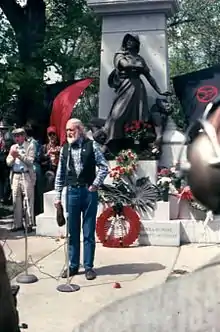Haymarket Martyrs' Monument
The Haymarket Martyrs' Monument is a funeral monument sculpture located at Forest Home Cemetery in Forest Park, Illinois, a suburb of Chicago. Dedicated in 1893, it commemorates the defendants involved in the labor unrest and bombing related to the Haymarket Affair (1886). On February 18, 1997, it was designated a National Historic Landmark.
Haymarket Martyrs' Monument | |
 Haymarket Martyrs' Monument in Forest Home Cemetery | |
 | |
| Location | The Forest Home Cemetery, Forest Park, Illinois. |
|---|---|
| Coordinates | 41°52′11″N 87°49′11″W |
| Built | Dedicated June 25, 1893 |
| Sculptor | Albert Weinert[1] |
| NRHP reference No. | 97000343[2] |
| Significant dates | |
| Added to NRHP | February 18, 1997[2] |
| Designated NHL | February 18, 1997 |
History
Following the Haymarket affair, trial and executions, August Spies, Adolph Fischer, George Engel, Louis Lingg, and Albert Parsons were buried at the German Waldheim Cemetery (later merged with Forest Home Cemetery).
The Pioneer Aid and Support Association organized a subscription for a funeral monument. In 1893, the Haymarket Martyrs' Monument by sculptor Albert Weinert was raised at Waldheim. It consists of a 16-foot-high granite shaft capped by a carved triangular stone. There is a two step base, which also supports a monumental figure of a woman standing over the body of a fallen worker, both in bronze. It was dedicated on June 25, 1893, after a march from Chicago. The inscription on the steps read, "1887", the year of the executions. Also, there is a quote attributed to Spies, recorded just before his execution by hanging: "The day will come when our silence will be more powerful than the voices you are throttling today."
On the back of the monument are listed the names of the men. On the top of the monument, a bronze plaque contains text of the pardon later issued by Illinois governor John Peter Altgeld.[2]
The dedication ceremony was attended by 8,000, with union flags and the American flag draped on the monument. European unions and American organizations sent flowers to be placed.[2] Many activists and labor leaders were subsequently buried nearby. Michael Schwab and Oscar Neebe were also buried at Waldheim when they died. Samuel Fielden is the only Haymarket defendant who is not buried at Forest Home. For years, annual commemorations were held.
Since the 1970s, the Illinois Labor History Society has held the deed to the monument and been responsible for its maintenance and restoration. It conducts monthly guided tours of Forest Home Cemetery from May through October.
Time capsule
In October 2016, volunteers and scientists dug near the base of the monument where they recovered an urn while searching for a lost time capsule that had been buried under the cornerstone on November 6, 1892, during the monument's construction. The urn was made of stone or concrete and capped in marble, 24 inches (62 cm) tall and 12 inches (30 cm) wide. According to a list in the records of the Pioneer Aid and Support Association, the lost time capsule is to contain newspaper articles, letters to and from the Haymarket defendants, and photographs of the men and their families. It also held trial documents, essays, and letters and testimonials from a number of labor unions and fraternal organizations. In addition, it may contain a bust of August Spies.[3][4] Research is ongoing to determine the location of the time capsule.[5]
The group that discovered the urn cylinder also found a smaller concrete cube thought to be a cremation vault for the ashes of Haymarket martyr Oscar Neebe, pardoned by Gov. John Altgeld, who died in 1916.[3][4]
Gallery
 Utah Phillips speaking in May 1986, during ceremonies commemorating the 100th anniversary of the Haymarket affair.
Utah Phillips speaking in May 1986, during ceremonies commemorating the 100th anniversary of the Haymarket affair. Haymarket Martyrs' Monument detail
Haymarket Martyrs' Monument detail Inscription at the base of the Haymarket Martyrs' Monument, "The day will come when our silence will be more powerful than the voices you are throttling today."
Inscription at the base of the Haymarket Martyrs' Monument, "The day will come when our silence will be more powerful than the voices you are throttling today." Rear of Haymarket Martyrs' Monument.
Rear of Haymarket Martyrs' Monument. National Historic Landmark plaque, at site of the Haymarket Martyrs' Monument; added in 1997.
National Historic Landmark plaque, at site of the Haymarket Martyrs' Monument; added in 1997.
References
- "Haymarket Martyrs' Monument, (sculpture)." SIRIS
- National Historic Landmark Nomination form, 1997 Haymarket Martyrs' Monument, Robin Bachin, Newberry Library.
- Lotus, Jean (October 6, 2016). "Archaeologists May Have Unearthed Haymarket Time Capsule". Cook County Chronicle. Retrieved November 5, 2016.
- Rice, John (October 4, 2016). "Haymarket Time Capsule Uncovered, Still Unopened". Forest Park Review. Retrieved November 5, 2016.
- Rice, John (October 18, 2016). "Cemetery cylinder isn't time capsule after all". Forest Park Review. Retrieved May 1, 2017.
External links
| Wikimedia Commons has media related to Haymarket Martyrs' Monument and graves. |